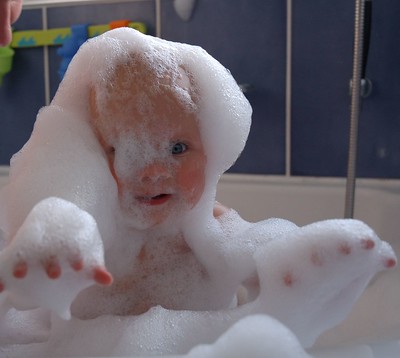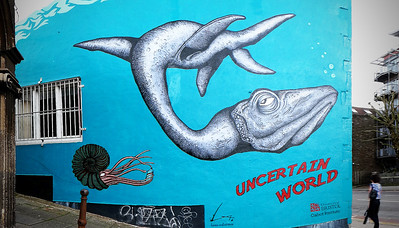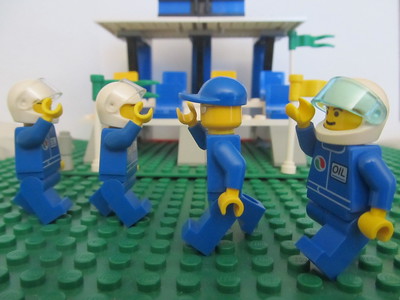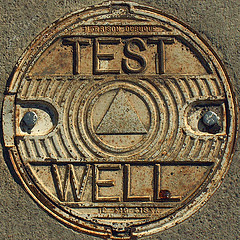Archive for the ‘Fundementals’ Category
Free Resources
 Since resources are expensive, it can be helpful to see the environment around your product as a source of inexpensive resources that can be modified to perform useful functions. Here are some examples.
Since resources are expensive, it can be helpful to see the environment around your product as a source of inexpensive resources that can be modified to perform useful functions. Here are some examples.
Gravity is a force you can use to do your bidding. Since gravity is always oriented toward the center of the earth, if you change the orientation of an object, you change the direction gravity exerts itself relative to the object. If you flip the object upside down, gravity will push instead of pull.
And it’s the same for buoyancy but in reverse. If you submerge an object of interest in water and add air (bubbles) from below, the bubbles will rise and push in areas where the bubbles collect. If you flip over the object, the bubbles will collect in different areas and push in the opposite direction relative to the object.
And if you have water and bubbles, you have a delivery system. Add a special substance to the air which will collect at the interface between the water and air and the bubbles will deliver it northward.
If you have motion, you also have wind resistance or drag force (but not in deep space). To create more force, increase speed or increase the area that interacts with the moving air. To change the direction of the force relative to the object, change the orientation of the object relative to the direction of motion.
If you have water, you can also have ice. If you need a solid substance look to the water. Flow water over the surface of interest and pull out heat (cool) where you want the ice to form. With this method, you can create a protective coating that can regrow as it gets worn off.
If you have water, you can make ice to create force. Drill a blind hole in a piece of a brittle material (granite), fill the hole with water, and freeze the water by cooling the granite (or leave it outside in the winter). When the water freezes it will expand, push on the granite and break it.
These are some contrived examples, but I hope they help you see a whole new set of free resources you can use to make your magic.
Thank you, VF.
Image credit – audi_insperation
Believe it or not, people’s capacity to do work is finite.
 When cars run out of gas, they can no longer get the job done until their tanks are filled up. And it’s the same with people, except people are asked to keep on truckin’ even though their tanks are empty.
When cars run out of gas, they can no longer get the job done until their tanks are filled up. And it’s the same with people, except people are asked to keep on truckin’ even though their tanks are empty.
When machines are used for a certain number of hours, they are supposed to be given rest and routine maintenance. If the maintenance isn’t completed as defined in the operator’s manual, the warranty is voided. Maybe we could create a maintenance schedule for people. And if it’s not done, we could be okay with reduced performance, like with a machine. And when the scheduled maintenance isn’t performed on time, maybe we could blame the person who prevented it from happening.
If your lawnmower could tell you when you were using it in a way that would cause it damage, would you listen and change your behavior? How about if a person said a similar thing to you? To which one would you show more compassion?
When your car’s check engine light comes on, would you pretend you don’t see it or would you think that the car is being less than truthful? What if a person tells you their body is throwing a warning light because of how you’re driving them? Would you believe them or stomp on the accelerator?
We expect our machines to wear out and need refurbishment. We expect our cars to run out of gas if we don’t add fuel. We expect our lawnmowers to stall if we try to mow grass that’s two feet tall. We expect that their capacities and capabilities are finite. Maybe we can keep all this in mind when we set expectations for our people.
“our ‘new’ lawnmower” by sharon_k is licensed under CC BY-SA 2.0.
Tell the truth, especially when it’s difficult.
 Our behavior is a result of causes and conditions. One thing paves the way for the next. Elements of the first thing create a preferential path for the next thing. If someone gets praised for doing A, more people will do A, even when A is the wrong behavior. If someone gets chastised for doing B, B won’t happen again, even when B is the right behavior.
Our behavior is a result of causes and conditions. One thing paves the way for the next. Elements of the first thing create a preferential path for the next thing. If someone gets praised for doing A, more people will do A, even when A is the wrong behavior. If someone gets chastised for doing B, B won’t happen again, even when B is the right behavior.
The most troubling set of causes and conditions are those that block people from telling their truth. When everyone knows it’s a bad idea, but no one is willing to say it out loud, that’s a big problem. In fact, it may be the biggest problem.
When people think they won’t be taken seriously, they keep their truth to themselves. When people know they will be dismissed, they keep quiet. When people feel the situation is hopeless because there’s no way they’ll be listened to, they say nothing.
When people see others not taken seriously, that creates conditions for future truths to be withheld. When people see others being dismissed, that creates conditions for future truths to be kept quiet. When people see others in others from not being listened to, that creates conditions for future truths to remain unsaid.
And causes and conditions are self-strengthening. The more causes and conditions are reinforced, the more the behaviors become ingrained. The more people are stifled, the more they will keep quiet. The more people are dismissed, the more they’ll shut up. The more people’s truths are ignored, the more they’ll remain unsaid.
Here are three rules for truth-telling that will help you and your company move forward:
- Without truth-telling, there can be no truth-telling.
- The longer truth-telling is stifled, the harder it is for truth-telling to reemerge.
- Truth-telling begets truth-telling.
Image credit — Jinterwas
Instead of rebranding, why not keep the brand and improve your offering?
 Cigarette companies rebranded themselves because their products caused cancer and they wanted to separate themselves from how their customers experienced their products. Their name and logo (which stand for their brand) were mapped to bad things (cancer) so they changed their name and logo. The bad things still happened, but the company was one step removed. There was always the option to stop causing cancer and to leave the name and logo as-is, but that would have required a real change, difficult change, a fundamental change. Instead of stopping the harm, cigarette companies ran away from their heritage and rebranded.
Cigarette companies rebranded themselves because their products caused cancer and they wanted to separate themselves from how their customers experienced their products. Their name and logo (which stand for their brand) were mapped to bad things (cancer) so they changed their name and logo. The bad things still happened, but the company was one step removed. There was always the option to stop causing cancer and to leave the name and logo as-is, but that would have required a real change, difficult change, a fundamental change. Instead of stopping the harm, cigarette companies ran away from their heritage and rebranded.
Facebook rebranded itself because its offering caused cancer of a different sort. And they, too, wanted to separate themselves from how their customers experienced their offering. The world mapped the Facebook brand to bullying, harming children, and misinformation that destroyed institutions. Sure, Facebook had the option to keep the name and logo and stop doing harm, but they chose to keep the harm and change the name and logo. Like the cigarette companies, they chose to keep the unskillful behavior and change their brand to try to sidestep their damaging ways. Yes, they could have changed their behavior and kept their logo, but they chose to change their logo and double down on their unhealthy heritage.
The cigarette companies and Facebook didn’t rebrand themselves to move toward something better, they rebranded to run away from the very thing they created, the very experience they delivered to their customers. In that way, they tried to distance themselves from their offering because their offering was harmful. And in that way, rebranding is most often about moving away from the experience that customers experience. And in that way, rebranding is hardly ever about moving toward something better.
One exception I can think of is a special type of rebranding that is a distillation of the brand, where the brand name gets shorter. Several made-up examples: Nike Shoes to Nike; MacDonalds Hamburgers to MacDonalds; and Netflix Streaming Services to Netflix. In all three cases, the offering hasn’t changed and customers still recognize the brand. Everyone still knows it’s all about cool footwear, a repeatable fast-food experience, and top-notch entertainment content. If anything, the connection with the heritage is concentrated and strengthened and the appeal is broader. If your rebranding makes the name longer or the message more nuanced, you get some credit for confusing your customers, but you don’t qualify for this special exception.
If you want to move toward something better, it’s likely better to keep the name and logo and change the offering to something better. Your brand has history and your customers have mapped the goodness you provide to your name and logo. Why not use that to your advantage? Why not build on what you’ve built and morph it slowly into something better? Why not keep the brand and improve the offering? Why not remap your good brand to an improved offering so that your brand improves slowly over time? Isn’t it more effective to use your brand recognition as the mechanism to attract attention to your improved offering?
In almost all cases, rebranding is a sign that something’s wrong. It’s expensive, it consumes a huge amount of company resources, and there’s little to no direct benefit to customers. When you feel the urge to rebrand, I strongly urge you to keep the brand and improve your offering. That way your customers will benefit and your brand will improve.
Image credit Quinn Dombrowski
When You Don’t Know What To Do…
 When you don’t know what to do, what do you do? This is a difficult question.
When you don’t know what to do, what do you do? This is a difficult question.
Here are some thoughts that may help you figure out what to do when you really don’t know.
Don’t confuse activity with progress.
Gather your two best friends, go off-site, and define the system as it is.
Don’t ask everyone what they think because the Collective’s thoughts will be diffuse, bland, and tired.
Get outside.
Draw a picture of how things work today.
Get a good meal.
Make a graph of goodness over time. If it’s still increasing, do more of what you did last time. If it’s flat, do something else.
Get some exercise.
Don’t judge yourself negatively. This is difficult work.
Get some sleep.
Help someone with their problem. The distraction will keep you out of the way as your mind works on it for you.
Spend time with friends.
Try a new idea at the smallest scale. It will likely lead to a better one. Repeat.
Use your best judgment.
Image credit – Andrew Gustar
Small Teams are Mighty
 When you want new thinking or rapid progress, create a small team.
When you want new thinking or rapid progress, create a small team.
When you have a small team, they manage the handoffs on their own and help each other.
Small teams hold themselves accountable.
With small teams, one member’s problem becomes everyone’s problem in record time.
Small teams can’t work on more than one project at a time because it’s a small team.
And when a small team works on a single project, progress is rapid.
Small teams use their judgment because they have to.
The judgment of small teams is good because they use it often.
On small teams, team members are loyal to each other and set clear expectations.
Small teams coordinate and phase the work as needed.
With small teams, waiting is reduced because the team members see it immediately.
When something breaks, small teams fix it quickly because the breakage is apparent to all.
The tight connections of a small team are magic.
Small teams are fun.
Small teams are effective.
And small teams are powered by trust.
“LEGO Octan pit crew celebrating High Five Day (held every third Thursday of April)” by Pest15 is marked with CC BY-SA 2.0.
Things I Sometimes Forget
 Clean-sheet designs are fun, right up until they don’t launch.
Clean-sheet designs are fun, right up until they don’t launch.
When you feel the urge to do a clean-sheet design, go home early.
When you don’t know how to make it better, make it worse and do the opposite.
Without trying, there is no way to know if it will work.
Trying sometimes feels like dying.
But without trying, nothing changes.
Agreement is important, but only after the critical decision has been made.
When there’s 100% agreement, you waited too long to make the decision.
When it’s unclear who the customer is, ask “Whose problem will be solved?”
When the value proposition is unclear, ask ‘What problem will be solved?”
When your technology becomes mature, no one wants to believe it.
When everyone believes the technology is mature, you should have started working on the new technology four years ago.
If your projects are slow, blame your decision-making processes.
Two of the most important decisions: which projects to start and which to stop.
All the action happens at the interfaces, but that’s also where two spans of control come together and chafe.
If you want to understand your silos and why they don’t play nicely together, look at the organizational chart.
When a company starts up, the product sets the organizational structure.
Then, once a company is mature, the organizational structure constrains the product.
At the early stages of a project, there’s a lot of uncertainty.
And once the project is complete, there’s a lot of uncertainty.
“Toys Never Forget” by Alyssa L. Miller is marked with CC BY 2.0.
If you can be one thing, be effective.
 If you’re asked to be faster, choose to be more effective. There’s nothing slower than being fast at something that doesn’t matter.
If you’re asked to be faster, choose to be more effective. There’s nothing slower than being fast at something that doesn’t matter.
If you’re given a goal to be more productive, instead, improve effectiveness. There’s nothing less productive than making the wrong thing.
If you’re measured on efficiency, focus on effectiveness. Customers don’t care about your efficiency when you ship them the wrong product.
If you’re asked to improve quality, that’s good because quality is an important element of effectiveness.
If you’re asked to demonstrate more activity, focus on progress, which is activity done in an effective way.
If you’re asked to improve your team, ask them how they can be more effective and do that.
Regardless of the question, the answer is effectiveness.
Image credit pbkwee.
When You Have No Slack Time…
 When you have no slack time, you can’t start new projects.
When you have no slack time, you can’t start new projects.
When you have no slack time, you can’t run toward the projects that need your help.
When you have no slack time, you have no time to think.
When you have no slack time, you have no time to learn.
When you have no slack time, there’s no time for concern for others.
When you have no slack time, there’s no time for your best judgment.
When there is no slack time, what used to be personal becomes transactional.
When there is no slack time, any hiccup creates project slip.
When you have no slack time, the critical path will find you.
When no one has slack time, one project’s slip ripples delay into all the others.
When you have no slack time, excitement withers.
When you have no slack time, imagination dies.
When you have no slack time, engagement suffers.
When you have no slack time, burnout will find you.
When you have no slack time, work sucks.
When you have no slack time, people leave.
I have one question for you. How much slack time do you have?
“Hurry up Leonie, we are late…” by The Preiser Project is licensed under CC BY 2.0
Testing is an important part of designing.
 When you design something, you create a solution to a collection of problems. But it goes far beyond creating the solution. You also must create objective evidence that demonstrates that the solution does, in fact, solve the problems. And the reason to generate this evidence is to help the organization believe that the solution solves the problem, which is an additional requirement that comes with designing something. Without this belief, the organization won’t go out to the customer base and convince them that the solution will solve their problems. If the sales team doesn’t believe, the customers won’t believe.
When you design something, you create a solution to a collection of problems. But it goes far beyond creating the solution. You also must create objective evidence that demonstrates that the solution does, in fact, solve the problems. And the reason to generate this evidence is to help the organization believe that the solution solves the problem, which is an additional requirement that comes with designing something. Without this belief, the organization won’t go out to the customer base and convince them that the solution will solve their problems. If the sales team doesn’t believe, the customers won’t believe.
In school, we are taught to create the solution, and that’s it. Here are the drawings, here are the materials to make it, here is the process documentation to build it, and my work here is done. But that’s not enough.
Before designing the solution, you’ve got to design the tests that create objective evidence that the solution actually works, that it provides the right goodness and it solves the right problems. This is an easy thing to say, but for a number of reasons, it’s difficult to do. To start, before you can design the right tests, you’ve got to decide on the right problems and the right goodness. And if there’s disagreement and the wrong tests are defined, the design community will work in the wrong areas to generate the wrong value. Yes, there will be objective evidence, and, yes, the evidence will create a belief within the organization that problems are solved and goodness is achieved. But when the sales team takes it to the customer, the value proposition won’t resonate and it won’t sell.
Some questions to ask about testing. When you create improvements to an existing product, what is the family of tests you use to characterize the incremental goodness? And a tougher question: When you develop a new offering that provides new lines of goodness and solves new problems, how do you define the right tests? And a tougher question: When there’s disagreement about which tests are the most important, how do you converge on the right tests?
Image credit — rjacklin1975
Why are people leaving your company?
 People don’t leave a company because they feel appreciated.
People don’t leave a company because they feel appreciated.
People don’t leave a company because they feel part of something bigger than themselves.
People don’t leave a company because they see a huge financial upside if they stay.
People don’t leave a company because they are treated with kindness and respect.
People don’t leave a company because they can make less money elsewhere.
People don’t leave a company because they see good career growth in their future.
People don’t leave a company because they know all the key players and know how to get things done.
People don’t leave the company so they can abandon their primary care physician.
People don’t leave a company because their career path is paved with gold.
People don’t leave a company because they are highly engaged in their work.
People don’t leave a company because they want to uproot their kids and start them in a new school.
People don’t leave a company because their boss treats them too well.
People don’t leave a company because their work is meaningful.
People don’t leave a company because their coworkers treat them with respect.
People don’t leave a company because they want to pay the commission on a real estate transaction.
People don’t leave a company because they’ve spent a decade building a Trust Network.
People don’t leave a company because they want their kids to learn to trust a new dentist.
People don’t leave a company because they have a flexible work arrangement.
People don’t leave a company because they feel safe on the job.
People don’t leave a company because they are trusted to use their judgment.
People don’t leave the company because they want the joy that comes from rolling over their 401k.
People don’t leave a company when they have the tools and resources to get the work done.
People don’t leave a company when their workload is in line with their capacity to get it done.
People don’t leave a company when they feel valued.
People don’t leave a company so they can learn a whole new medical benefits plan.
People don’t leave a job because they get to do the work the way they think it should be done.
So, I ask you, why are people leaving your company?
“Penguins on Parade” by D-Stanley is licensed under
 Mike Shipulski
Mike Shipulski